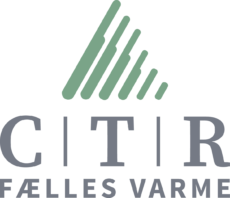ABOUT CTR
In the Greater Copenhagen Area five municipalities have joined forces to implement and operate a common district heating system. In 1984 the municipalities of Frederiksberg, Gentofte, Gladsaxe, Copenhagen and Taarnby formed the Metropolitan Copenhagen Heating Transmission company - known as CTR.
DISTRICT HEATING IS FUTURE-ORIENTED HEATING
A holistic approach must be taken when attempting to solve environmental problems. The district heating system is a future-oriented infrastructure, which ensures that the heating supply of a large city can become greener and greener, as and when new technological solutions are developed. When supplying densely populated areas in Denmark with energy, fossil fuels are consumed. This results in the emission of CO2. That is the way it is today and, despite technical advances, that is the way it will be many years into the future.
Consequently, the big challenge is to limit the consumption of fossil fuels as much as possible, and this is where Metropolitan Copenhagen has made more progress than many similar capitals. This is due primarily to the extended district heating system, which was decided politically almost 25 years ago, and to which most citizens and companies that require heating are connected today. District heating is an effective, sustainable solution in big, densely populated cities, because the energy savings obtained are massive. Fuels are used optimally and the heat loss is minimal when heat is transported to the customers.
District heating reduces energy consumption
There are a number of reasons why the district heating system considerably reduces energy consumption and thus CO2 emissions. Combined Heat and Power (CHP), where district heating is generated together with electricity, offers huge energy savings if compared with a situation in which electricity and heat are generated separately. This is because the heat from electricity generation is utilized.
The excess heat from the incineration of waste can be collected and transported as district heating to consumers. Without the district heating system, all this heat would be lost and would have to be cooled down – e.g. by being discharged into the sea.
The district heating system has also made it possible to gather heat generation in modern, large-scale plants that are centrally located. This provides added efficiency, since a small number of large district heating plants are able to generate heat for the city much more effectively than many, small, private facilities. Space is a scarce commodity in big cities, so it is advantageous to reduce the number of production plants as much as possible. They take up space – physically as well as aesthetically.
Environmentally benign fuels can be prioritized
It takes a considerable amount of fuel to cover the heating requirements of the five municipalities that are supplied via CTR’s district heating system. Today, the fuel used is a combination of fossil and CO2-neutral fuels, with green fuels gradually gaining ground.
Among the fossil fuels, CHP Plants have increased the use of natural gas over coal in recent years. This helps reduce CO2emissions. Straw pellets, wood pellets and most of incineration waste form the basis of the CO2-neutral fuels. A geothermal facility is also active, pumping heat up from the underground to district heating customers.
The district heating system allows CTR to give priority to the most environmentally benign fuels and heating plants at any given time. This prioritization is based on political decisions and regulated through legislation, e.g. via taxes and agreements on the use of biomass. However, it is the district heating system that guarantees flexibility and enables the enhancement of environmental ambitions.
Only technical advancements are the limit as regards the CO2-neutral energy sources that can be connected to the district heating system.
District heating is sustainable on different levels
If sustainable development of a big city is to be ensured, the environment, the economy and other aspects of importance to the wellbeing of inhabitants must be combined and optimized. The district heating system represents one example of such a holistic approach.
District heating is not just good for the environment. In addition, the individual consumer will have a stable, simple and reliable supply of heat. Moreover, effective utilization of fuels and the flexibility of the system make substantial financial savings to the benefit of consumers and society alike.
View large map.


